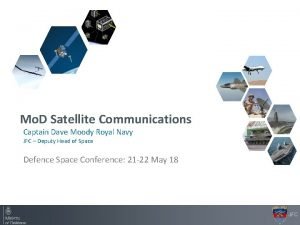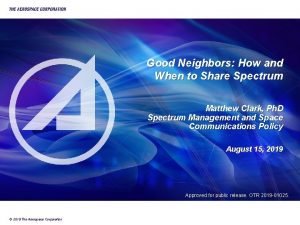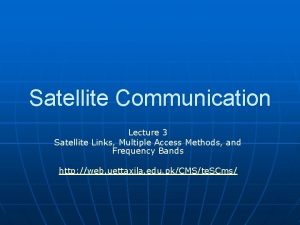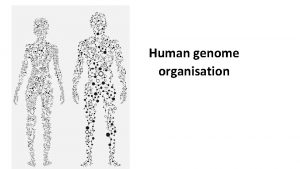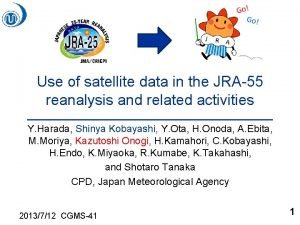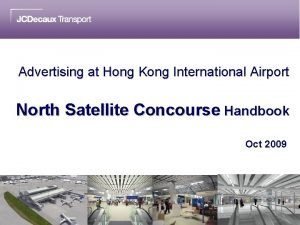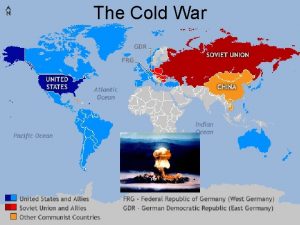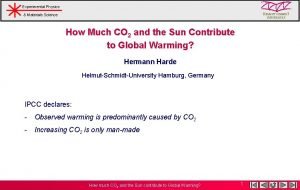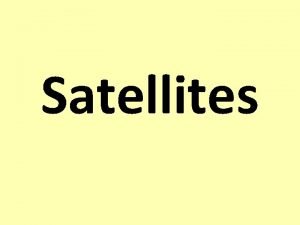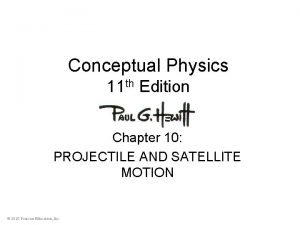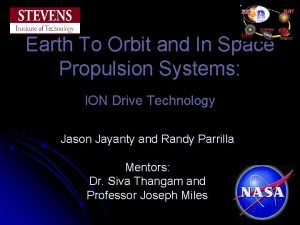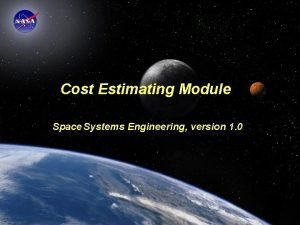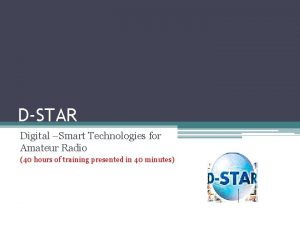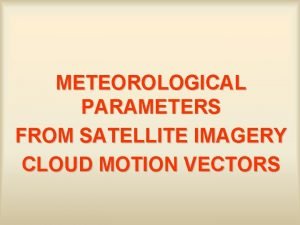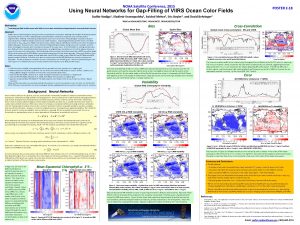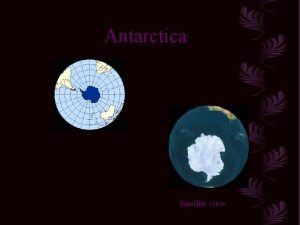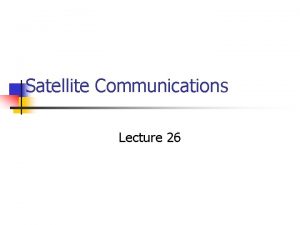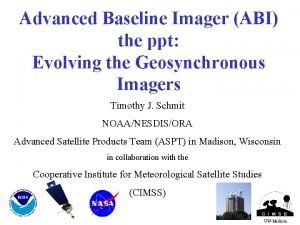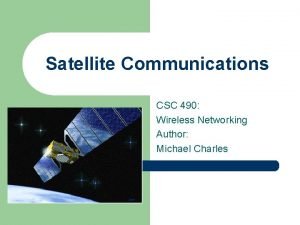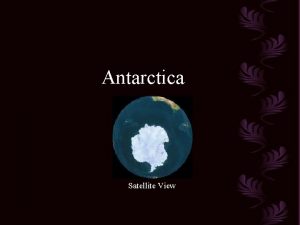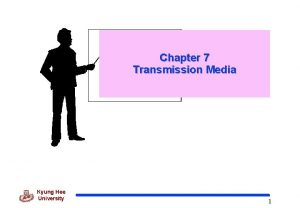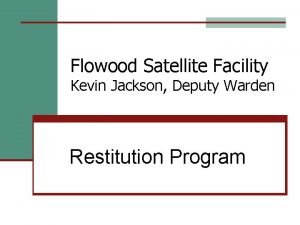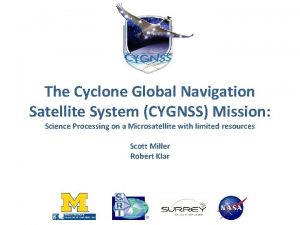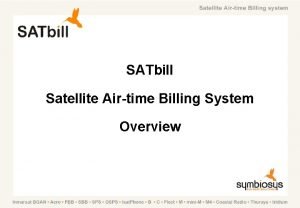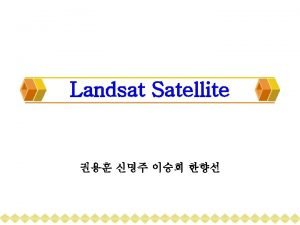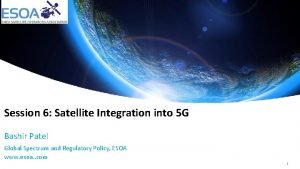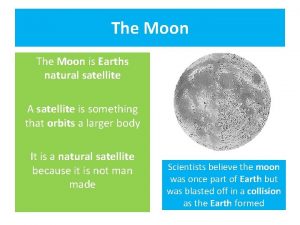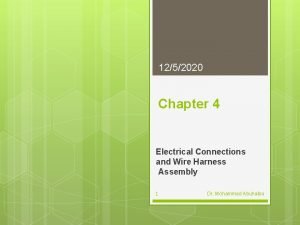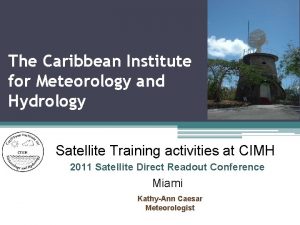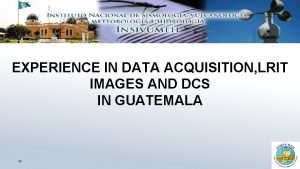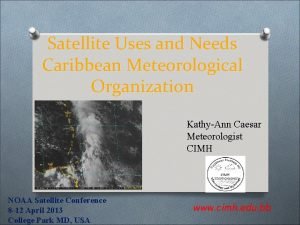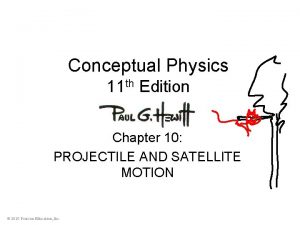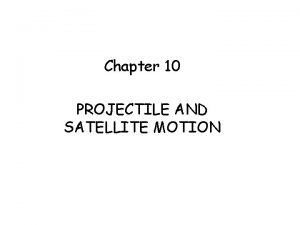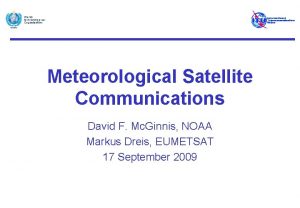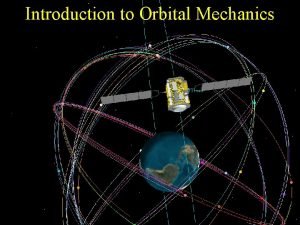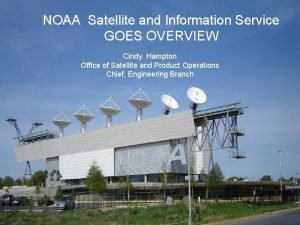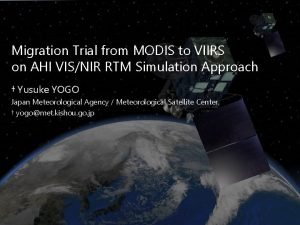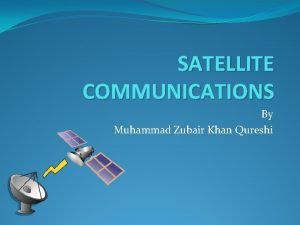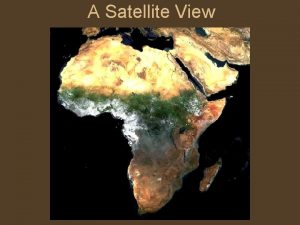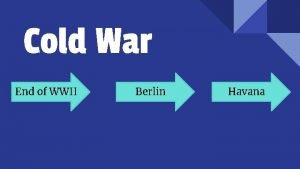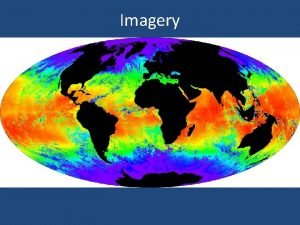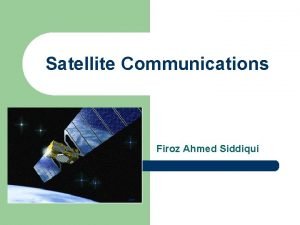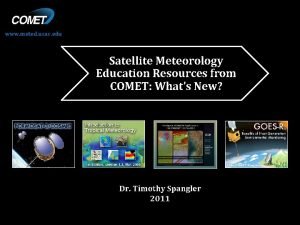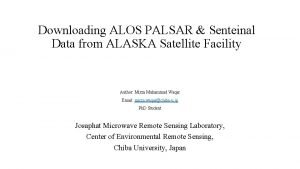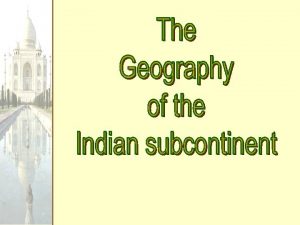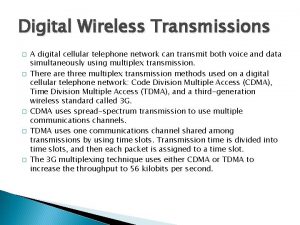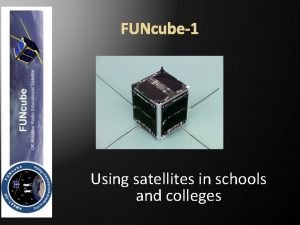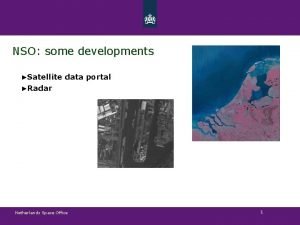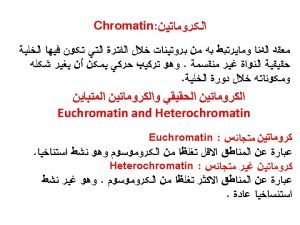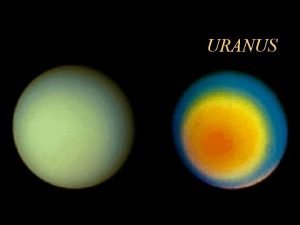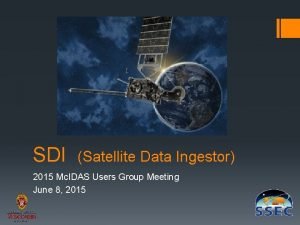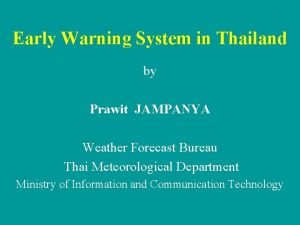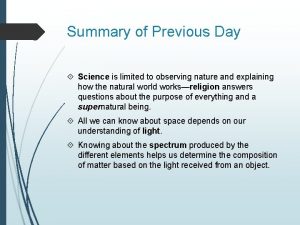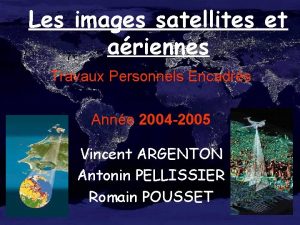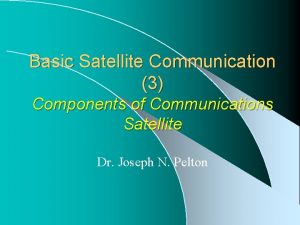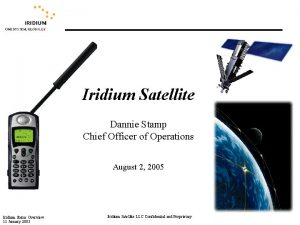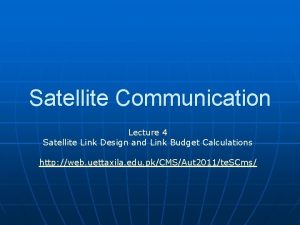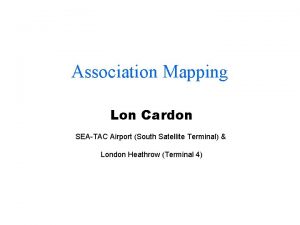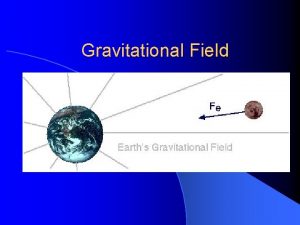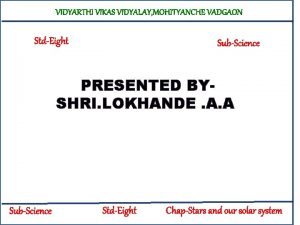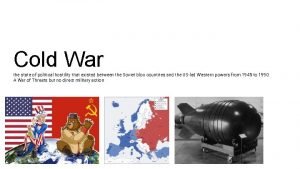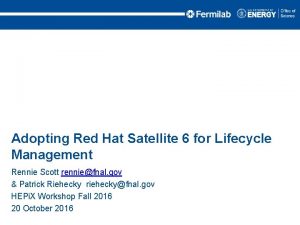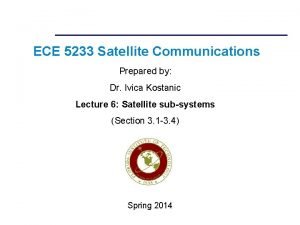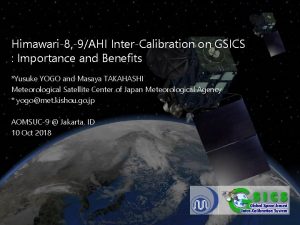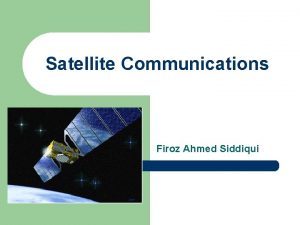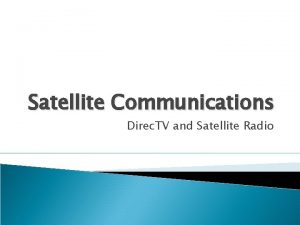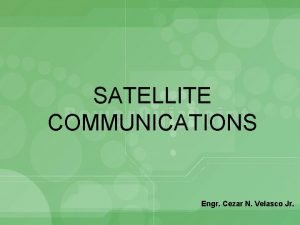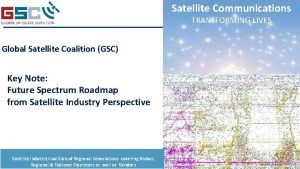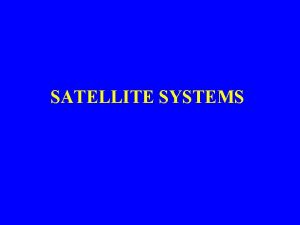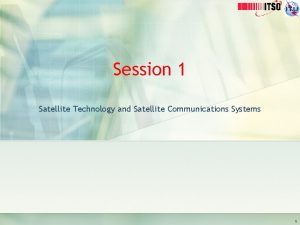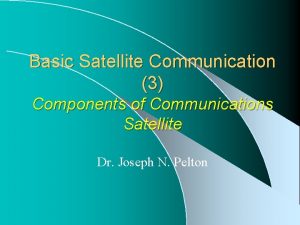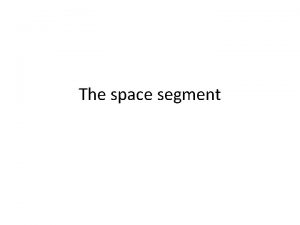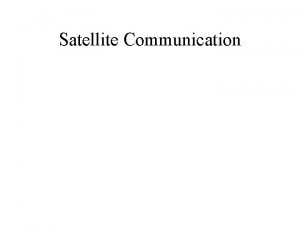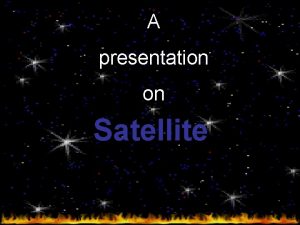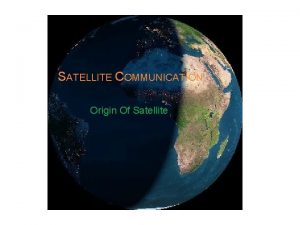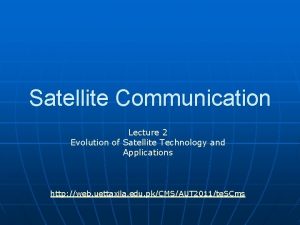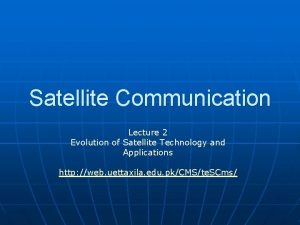Satellite Communications Lecture 26 Overview n n n





























































![Earth’s atmosphere n Source: All about GPS [www. kowoma. de] 62 Earth’s atmosphere n Source: All about GPS [www. kowoma. de] 62](https://slidetodoc.com/presentation_image/fb8ae79c2c0c6a34fa3e465d0b9800c7/image-62.jpg)





























- Slides: 91

Satellite Communications Lecture 26

Overview n n n n Requirement of Satellite Communication Satellite Up. Link and Down. Link Types of Satellites Satellite Foot Print (Coverage Area) Satellite Transmission Bands Up. Link and Down. Link Frequencies Signal Propagation Delay Transponder Effect of Rain on Satellite Communication Microwave Communication (Why) Satellite System Elements Losses Capacity Allocation Strategies 2

Why Satellite Communication? n n The Earth is a sphere & the microwave frequencies travel in straight line but to connect two regions very far away on the two side of the sphere, the link requires lot of repeaters because of Earth’s curvature. A single satellite can do the magic linking the continents with one repeater. 3

Motivation to use Satellites 4

Communication Satellite n n A Communication Satellite can be looked upon as a large microwave repeater It contains several transponders which listens to some portion of spectrum, amplifies the incoming signal and broadcasts it in another frequency to avoid interference with incoming signals. 5

6

Satellite n It is a repeater which receives signal from Earth at one frequency, amplify it & transmit it back to Earth at other frequency. 7

EARTH STATION n n There are two earth station in a simple Satellite communication link. One transmits the signal to satellite called transmitting Earth station. The other receives the signal from satellite called receiving Earth Station. 8

UPLINK & DOWN LINK n n The communication link from Transmitting earth station to satellite is called Up-link. The communication link from satellite To receiving earth station is called Down-link. 9

Altitudes of Orbits Above the Earth n There are 3 common types of satellite based on altitude, i. e. GEO, MEO & LEO Orbit Altitude Missions possibles 250 to 1, 500 km Earth observation, meteorology, telecommunications (constellations) Medium-Earth orbit MEO 10, 000 to 30, 000 km Telecommunications (constellations), positioning, science Geostationary Earth orbit GEO 35, 786 km Telecommunications, positioning, science Elliptical orbit Between 800 and 27, 000 km Telecommunications Hyperbolic orbit Up to several million km Interplanetary missions Low-Earth orbit LEO 10

11

Types of Satellite Orbits n Based on the inclination, i, over the equatorial plane: n n Equatorial Orbits above Earth’s equator (i=0°) Polar Orbits pass over both poles (i=90°) Other orbits called inclined orbits (0°<i<90°) Based on Eccentricity n n Circular with centre at the earth’s centre Elliptical with one foci at earth’s centre 12

Types of Satellite based Networks n Based on the Satellite Altitude n GEO – Geostationary Orbits n n MEO – Medium Earth Orbits n n High bandwidth, High power, High latency LEO – Low Earth Orbits n n 36000 Km = 22300 Miles, equatorial, High latency Low power, Low latency, More Satellites, Small Footprint VSAT n Very Small Aperture Satellites n Private WANs 13

Satellite Orbits n n n Geosynchronous Orbit (GEO): 36, 000 km above Earth, includes commercial and military communications satellites, satellites providing early warning of ballistic missile launch. Medium Earth Orbit (MEO): from 5000 to 15000 km, they include navigation satellites (GPS, Galileo, Glonass). Low Earth Orbit (LEO): from 500 to 1000 km above Earth, includes military intelligence satellites, weather satellites. 14

Satellite Orbits 15

GEO - Geostationary Orbit n n n In the equatorial plane Orbital Period = 23 h 56 m 4. 091 s = 1 sidereal day* Satellite appears to be stationary over any point on equator: n n Earth Rotates at same speed as Satellite Radius of Orbit r = Orbital Height + Radius of Earth Avg. Radius of Earth = 6378. 14 Km 3 Satellites can cover the earth (120° apart) 16

NGSO - Non Geostationary Orbits n Orbit should avoid Van Allen radiation belts: n n Region of charged particles that can cause damage to satellite Occur at n n ~2000 -4000 km and ~13000 -25000 km 17

LEO - Low Earth Orbits n Circular or inclined orbit with < 1400 km altitude n n n Satellite travels across sky from horizon to horizon in 5 - 15 minutes => needs handoff Earth stations must track satellite or have Omni directional antennas Large constellation of satellites is needed for continuous communication (66 satellites needed to cover earth) Requires complex architecture Requires tracking at ground 18

HEO - Highly Elliptical Orbits n n n HEOs (i = 63. 4°) are suitable to provide coverage at high latitudes (including North Pole in the northern hemisphere) Depending on selected orbit (e. g. Molniya, Tundra, etc. ) two or three satellites are sufficient for continuous time coverage of the service area. All traffic must be periodically transferred from the “setting” satellite to the “rising” satellite (Satellite Handover) 19

Satellite Orbits 20

Why Satellites Remain in Orbits 21

22

Orbital Period n n The time taken by a satellite to complete one rotation in its orbit is called its period. The GEO satellite takes 23 hrs & 56 minutes & 4. 1 Seconds to complete its rotation which is approximately equal to the period of rotation of earth around its axis. This is why it appears to be stationary by the observer on Earth moving with the same speed as that of satellite. So one GEO stationary satellite can serve a ground 23 user round the clock.

Orbital Period Satellite System Orbital Height (Km) Orbital Velocity (Km/Sec) Orbital Period (H M S) Intelsat (GEO) 35, 786 3. 0747 23 56 4. 1 New ICO (MEO) 10, 255 4. 8954 5 55 48. 4 Iridium (LEO) 1, 469 7. 1272 1 55 17. 8 Notice as altitude decreases, the velocity must be increased to minimize the gravitational effect. 24

Coverage Area of Satellite n The Earth surface covered by satellite radiations is called FOOT PRINT. The coverage area is inversely proportional to frequency. The foot print will be large if the frequency of down link is low. 25

GEO satellite Coverage n n One GEO can cover 1/3 of earth surface so the earth is divided in 3 regions. AOR (Atlantic Ocean Region) POR (Pacific Ocean region) IOR (Indian Ocean region) 26

FREQUENCIES for Satellite Communication Letter Designation Frequency range USE L band 1 to 2 GHz Satellite phone, GPS S band 2 to 4 GHz Satellite phone C band 4 to 8 GHz TV transmission X band 8 to 12 GHz Ku band 12 to 18 GHz K band 18 to 26. 5 GHz Ka band 26. 5 to 40 GHz Satellite Internet Q band 30 to 50 GHz Experimental U band 40 to 60 GHz TV transmission, Communication Experimental 27

Satellite Transmission Bands Frequency Band C Downlink Uplink 3, 700 -4, 200 MHz 5, 925 -6, 425 MHz Ku 11. 7 -12. 2 GHz 14. 0 -14. 5 GHz Ka 17. 7 -21. 2 GHz 27. 5 -31. 0 GHz The C band is the most frequently used. The Ka and Ku bands are reserved exclusively for satellite communication but are subject to rain attenuation 28

FREQUENCIES For Uplink & Down link n n n Uplink uses higher frequency than the down link. Frequency of satellite is always specified as UPLINK frequency/ Down link Frequency e. g. C band 6/4 GHz Ku band 14/11 GHz Ka band 30/20 GHz 29

Signal Propagation DELAY n n Using c= 3*10 ^ 8 m/s & time= distance(altitude)/ speed Uplink delay from earth station to Satellite. Round trip delay 4* uplink delay. All other delays in signal coding, compression, & processing on Satellite & earth Station are neglected. orbit Average altitude Uplink Delay of Orbit Round trip delay LEO 800 Km 2. 7 ms 10. 8 ms MEO 10, 355 Km 34. 5 ms 138 ms GEO 35, 786 Km 119. 3 ms 480 ms = ½ Second 30

Round trip delay of GEO signal 31

Transponder n n The BW of satellite is divided into channels allowing many earth stations to use this BW. The Electronics to support each channel is called Transponder. Each transponder consist of band pass filter to select particular channel, down converter & output amplifier. Each satellite can have a large number of active & spare transponders typically 12 to 44 active transponder in each satellite. The total BW of transponder is usually 36, 54 or 72 MHz. 32

Transponder 33

Effect of rain on signal n n Rain heavily effects the wireless communication above 10 GHz. So Ku band & Ka band will be effected by rain & specially above 20 GHz the Ka Band link can fail during heavy rain fall. 34

Why fup is always Higher than fdown? n n The beam of higher frequency is narrow & that of lower is broad. As the earth station has to target the signal to a small point (satellite) in space so it does it by using narrow beam produced by higher frequency. While the Satellite has to cover a large area on earth to provide services to many Earth station so it does it by using broad beam produced by lower frequency. As the rain effects higher frequencies more than lower one so they need to be boosted up more to overcome the propagation losses. The Energy can be given to signal much more easily on earth than on satellite because the satellite has limited power resources like solar cells & batteries so we use higher frequencies on Earth & amplify them with enough power supply 35 resources we have on Earth

Up & down frequencies of C band 36

Satellite Signals n Base band signals can be analog or digital. But the final signal transmitted towards the satellite or from the satellite is always analog as it is an RF signal. 37

Increasing bandwidth of Satellite n n n Multiplexing Use of Audio & video compression in telephone & TV signals. Frequency Reuse Same frequency but orthogonal polarization. Increasing angular spacing of two satellites in same orbit using similar frequencies. 38

Life of Satellite n n A satellite has two life. Design life: it is the predicted life of the electronic systems working in satellite. Maneuver life: It is the life during which full maneuver capabilities exist in satellite to change its position. It depends on fuel tank storage capacity & it is usually less than design life. At the end of useful GEO satellite life , it is raised to graveyard orbit. 39

Uses of Satellite n n n n Military communication Telecommunication Satellite phone. VSAT (very small aperture terminal) Cable TV DBS (Direct Broadcast Satellite) TV (with Dish Antenna) GPS (Global Positioning System) Satellite Internet Weather forecasting Photography GIS (geographical Information System) X-Ray & infrared view of universe Navigation Deep Space exploration & many more 40

41

Satellite Missions 42

Satellite Microwave Transmission n n Satellites can relay signals over a long distance Geostationary Satellites n n Remain above the equator at a height of about 22300 miles (geosynchronous orbits) Travel around the earth in exactly the same time, the earth takes to rotate 43

Why Do Microwaves are Used for Satellite Communications? n n n High enough frequency to carry the information, long enough wavelength to penetrate the atmosphere. They do not rapidly disperse in the atmosphere so the power does not need to be very high to reach a distant point. They can be focused by a suitable dish to increase the reception of low power signals. They can be modulated to carry the signal and are resistant to interference. They travel in straight enough lines to be able to aim them. They are easy to produce and easy to detect. 44

Satellite System Elements 45

Space Segment n n Satellite Launching Phase Transfer Orbit Phase Deployment Operation n n TT&C - Tracking Telemetry and Command Station SSC - Satellite Control Center, a. k. a. : n n n OCC - Operations Control Center SCF - Satellite Control Facility Retirement Phase 46

Ground Segment n Collection of facilities, Users and Applications 47

Satellite Uplink and Downlink n n Uplink n n The link from a satellite down to one or more ground stations or receivers The link from a ground station up to a satellite. Some companies sell uplink and downlink services to n n television stations, corporations, and to other telecommunication carriers. A company can specialize in providing uplinks, downlinks, or both. 48

Why Two Frequencies for Uplink and Downlink in Satellite Com The reason the uplink and downlink frequencies are different in satellites is because otherwise the satellite's transmitter and receiver would interfere with one another. The signals have to operate on different frequencies. But n If you could send a signal, then wait, the receiver could be protected from the transmitted signal on the same frequency, but with high speed, continuous transmission, the receiver cannot be turned off while the transmitter is transmitting. (an example of something that transmits and receives on the same frequency is pulsed RADAR, where the transmitter sends out a pulse, and then the echo is picked up by the receiver) n 49

Why Uplink Frequency is Higher than Downlink Frequency n n The signals have to cross the atmosphere which presents a great deal of attenuation. The higher the frequency, the more is the signal loss and more power is needed for reliable transmission. A satellite is a light-weight device which cannot support highpower transmitters on it. So, it transmits at a lower frequency (higher the frequency, higher is the transmitter power to accommodate losses) as compared to the stationary earth station which can afford to use very high-power transmitters. This is compensated by using highly sensitive receiver circuits on the earth station which is in the line-of-sight (LOS) of the satellite. 50

Uplink/Downlink Mobile/Satellite A mobile is a portable device which cannot afford high-power transmission as it has a small battery with limited power. The 'free space path loss' comes to play. The higher the transmitting frequency, the higher is the loss. Since a mobile station (cellphone) cannot afford to transmit at high power to compensate for this loss, it must transmit on a lower frequency as a lower frequency presents lesser free space path loss. Therefore, mobile-to-base station (uplink) frequencies are lower than base station-to-mobile(downlink) frequencies. 51

Satellite Uplink and Downlink 52

Satellite Communication n When using a satellite for long distance communications, the satellite acts as a repeater. An earth station transmits the signal up to the satellite (uplink), which in turn retransmits it to the receiving earth station (downlink). Different frequencies are used for uplink/downlink. 53

Satellite Transmission Links n n n Earth stations Communicate by sending signals to the satellite on an uplink The satellite then repeats those signals on a downlink The broadcast nature of downlink makes it attractive for services such as the distribution of TV programs 54

Direct to User Services One way Service (Broadcasting) Two way Service (Communication) 55

Satellite Signals n Used to transmit signals and data over long distances n n Weather forecasting Television broadcasting Internet communication Global Positioning Systems 56

Advantages of Satellite Communication n n n Can reach over large geographical area Flexible (if transparent transponders) Easy to install new circuits Circuit costs independent of distance Broadcast possibilities Temporary applications (restoration) Niche applications Mobile applications (especially "fill-in") Terrestrial network "by-pass" Provision of service to remote or underdeveloped areas User has control over own network 1 -for-N multipoint standby possibilities 57

Disadvantages of Satellite Communication n n Large up front capital costs (space segment and launch) Terrestrial break even distance expanding (now approx. size of Europe) Interference and propagation delay Congestion of frequencies and orbits 58

When to use Satellites n n When the unique features of satellite communications make it attractive When the costs are lower than terrestrial routing When it is the only solution Examples: n n n n Communications to ships and aircraft (especially safety communications) TV services - contribution links, direct to cable head, direct to home Data services - private networks Overload traffic Delaying terrestrial investments 1 for N diversity 59 Special events

When to use Terrestrial n n PSTN - satellite is becoming increasingly uneconomic for most trunk telephony routes but, there are still good reasons to use satellites for telephony such as: thin routes, diversity, very long distance traffic and remote locations. Land mobile/personal communications - in urban areas of developed countries new terrestrial infrastructure is likely to dominate (e. g. GSM, etc. ) but, satellite can provide fill-in as terrestrial networks are implemented, also provide similar services in rural areas and underdeveloped countries 60

Frequency Bands Allocated to the FSS(Fixed service satellite) n n Frequency bands are allocated to different services at World Radio-communication Conferences (WRCs). Allocations are set out in Article S 5 of the ITU Radio Regulations. It is important to note that (with a few exceptions) bands are generally allocated to more than one radio services. CONSTRAINTS n Bands have traditionally been divided into “commercial" and "government/military" bands, although this is not reflected in the Radio Regulations and is becoming less clear-cut as "commercial" operators move to utilize "government" bands. 61
![Earths atmosphere n Source All about GPS www kowoma de 62 Earth’s atmosphere n Source: All about GPS [www. kowoma. de] 62](https://slidetodoc.com/presentation_image/fb8ae79c2c0c6a34fa3e465d0b9800c7/image-62.jpg)
Earth’s atmosphere n Source: All about GPS [www. kowoma. de] 62

Atmospheric Losses n Different types of atmospheric losses can disturb radio wave transmission in satellite systems: n n n Atmospheric absorption Atmospheric attenuation Traveling ionospheric disturbances 63

Atmospheric Absorption n Energy absorption by atmospheric gases, which varies with the frequency of the radio waves. Two absorption peaks are observed (for 90º elevation angle): n 22. 3 GHz from resonance absorption in water vapour (H 2 O) n 60 GHz from resonance absorption in oxygen (O 2) For other elevation angles: n [AA] = [AA]90 cosec 64

Atmospheric Attenuation n n Rain is the main cause of atmospheric attenuation (hail, ice and snow have little effect on attenuation because of their low water content). Total attenuation from rain can be determined by: n A = L [d. B] n where [d. B/km] is called the specific attenuation, and can be calculated from specific attenuation coefficients in tabular form that can be found in a number of publications n where L [km] is the effective path length of the signal through the rain; note that this differs from the geometric path length due to fluctuations in the rain density. 65

Traveling Ionospheric Disturbances n n Traveling ionospheric disturbances are clouds of electrons in the ionosphere that provoke radio signal fluctuations which can only be determined on a statistical basis. The disturbances of major concern are: n Scintillation; n Polarisation rotation. Scintillations are variations in the amplitude, phase, polarisation, or angle of arrival of radio waves, caused by irregularities in the ionosphere which change over time. The main effect of scintillations is fading of the signal. 66

What is Polarisation? n n Polarisation is the property of electromagnetic waves that describes the direction of the transverse electric field. Since electromagnetic waves consist of an electric and a magnetic field vibrating at right angles to each other. it is necessary to adopt a convention to determine the polarisation of the signal. Conventionally, the magnetic field is ignored and the plane of the electric field is used. 67

Types of Polarisation n Linear Polarisation Circular Polarisation Linear Polarisation (horizontal or vertical): n the two orthogonal components of the electric field are in phase; n The direction of the line in the plane depends on the relative amplitudes of the two components. Circular Polarisation: n The two components are exactly 90º out of phase and have exactly the same amplitude. Elliptical Polarisation: n All other cases. 68

Satellite Communications n n n Alternating vertical and horizontal polarisation is widely used on satellite communications This reduces interference between programs on the same frequency band transmitted from adjacent satellites (One uses vertical, the next horizontal, and so on) Allows for reduced angular separation between the satellites. 69

70

Ways to Categorize Communications Satellites n Coverage area n n Service type n n Global, regional, national Fixed service satellite (FSS) Broadcast service satellite (BSS) Mobile service satellite (MSS) General usage n Commercial, military, amateur, experimental 71

Classification of Satellite Orbits n Circular or elliptical orbit n n n Orbit around earth in different planes n n Circular with center at earth’s center Elliptical with one foci at earth’s center Equatorial orbit above earth’s equator Polar orbit passes over both poles Other orbits referred to as inclined orbits Altitude of satellites n n n Geostationary orbit (GEO) Medium earth orbit (MEO) Low earth orbit (LEO) 72

Minimum Elevation Angle n Reasons affecting minimum elevation angle of earth station’s antenna (>0 o) n n n Buildings, trees, and other terrestrial objects block the line of sight Atmospheric attenuation is greater at low elevation angles Electrical noise generated by the earth's heat near its surface adversely affects reception 73

GEO Orbit n Advantages of the GEO orbit n n No problem with frequency changes Tracking of the satellite is simplified High coverage area Disadvantages of the GEO orbit n n n Weak signal after traveling over 35, 000 km Polar regions are poorly served Signal sending delay is substantial 74

LEO Satellite Characteristics n n n n Circular/slightly elliptical orbit under 2000 km Orbit period ranges from 1. 5 to 2 hours Diameter of coverage is about 8000 km Round-trip signal propagation delay less than 20 ms Maximum satellite visible time up to 20 min System must cope with large Doppler shifts Atmospheric drag results in orbital deterioration 75

LEO Categories n Little LEOs n n n Frequencies below 1 GHz 5 MHz of bandwidth Data rates up to 10 kbps Aimed at paging, tracking, and low-rate messaging Big LEOs n n n Frequencies above 1 GHz Support data rates up to a few megabits per sec Offer same services as little LEOs in addition to voice and positioning services 76

MEO Satellite Characteristics n n n Circular orbit at an altitude in the range of 5000 to 12, 000 km Orbit period of 6 hours Diameter of coverage is 10, 000 to 15, 000 km Round trip signal propagation delay less than 50 ms Maximum satellite visible time is a few hours 77

Frequency Bands Available for Satellite Communications 78

Satellite Link Performance Factors n n Distance between earth station antenna and satellite antenna For downlink, terrestrial distance between earth station antenna and “aim point” of satellite n n Displayed as a satellite footprint (Figure 9. 6) Atmospheric attenuation n Affected by oxygen, water, angle of elevation, and higher frequencies 79

Satellite Network Configurations 80

Capacity Allocation Strategies n n n Frequency division multiple access (FDMA) Time division multiple access (TDMA) Code division multiple access (CDMA) 81

Frequency-Division Multiplexing n Alternative uses of channels in point-to-point configuration n n n 1200 voice-frequency (VF) voice channels One 50 -Mbps data stream 16 channels of 1. 544 Mbps each 400 channels of 64 kbps each 600 channels of 40 kbps each One analog video signal Six to nine digital video signals 82

Frequency-Division Multiple Access n Factors which limit the number of subchannels provided within a satellite channel via FDMA n n n Thermal noise Intermodulation noise Crosstalk 83

Forms of FDMA n Fixed-assignment multiple access (FAMA) n n The assignment of capacity is distributed in a fixed manner among multiple stations Demand may fluctuate Results in the significant underuse of capacity Demand-assignment multiple access (DAMA) n Capacity assignment is changed as needed to respond optimally to demand changes among the multiple stations 84

FAMA-FDMA n n n FAMA – logical links between stations are preassigned FAMA – multiple stations access the satellite by using different frequency bands Uses considerable bandwidth 85

DAMA-FDMA n Single channel per carrier (SCPC) – bandwidth divided into individual VF channels n n n Attractive for remote areas with few user stations near each site Suffers from inefficiency of fixed assignment DAMA – set of subchannels in a channel is treated as a pool of available links n n For full-duplex between two earth stations, a pair of subchannels is dynamically assigned on demand Demand assignment performed in a distributed fashion by earth station using CSC 86

Reasons for Increasing Use of TDM Techniques n n Cost of digital components continues to drop Advantages of digital components n n Use of error correction Increased efficiency of TDM n Lack of intermodulation noise 87

FAMA-TDMA Operation n Transmission in the form of repetitive sequence of frames n n n Earth stations take turns using uplink channel n n Sends data in assigned time slot Satellite repeats incoming transmissions n n Each frame is divided into a number of time slots Each slot is dedicated to a particular transmitter Broadcast to all stations Stations must know which slot to use for transmission and which to use for reception 88

FAMA-TDMA Uplink 89

FAMA-TDMA Downlink 90

Summary n n n n Requirement of Satellite Communication Satellite Up. Link and Down. Link Types of Satellites Satellite Foot Print (Coverage Area) Satellite Transmission Bands Up. Link and Down. Link Frequencies Signal Propagation Delay Transponder Effect of Rain on Satellite Communication Microwave Communication (Why) Satellite System Elements Losses Capacity Allocation Strategies 91
 Skynet 6 service delivery wrap
Skynet 6 service delivery wrap Overview of integrated marketing communications
Overview of integrated marketing communications Overview of graphic communications
Overview of graphic communications Crisis communications lecture
Crisis communications lecture 01:640:244 lecture notes - lecture 15: plat, idah, farad
01:640:244 lecture notes - lecture 15: plat, idah, farad How oneweb about with spacex satellite
How oneweb about with spacex satellite Satellite communication
Satellite communication Human genome structure
Human genome structure Satellite system
Satellite system North satellite concourse
North satellite concourse What is a satellite nation
What is a satellite nation International satellite cloud climatology project
International satellite cloud climatology project Polar satellite uses
Polar satellite uses Ussr satellite states
Ussr satellite states Satellite city
Satellite city Tossed ball conceptual physics answers
Tossed ball conceptual physics answers Satellite propulsion system
Satellite propulsion system Satellite cost estimation
Satellite cost estimation Dstar satellite
Dstar satellite Kalpana satellite images
Kalpana satellite images Noaa satellite images
Noaa satellite images Thuraya satellite
Thuraya satellite Antarctica satellite view
Antarctica satellite view Broadband donegal
Broadband donegal A satellite can fail for many possible reasons
A satellite can fail for many possible reasons Centralized pharmacy
Centralized pharmacy Satellite frequency band
Satellite frequency band Satellite derived winds
Satellite derived winds Advantages of satellite
Advantages of satellite Satellite view of antarctica
Satellite view of antarctica Satellite microwave transmission
Satellite microwave transmission Mississippi restitution centers
Mississippi restitution centers Cyclone global navigation satellite system
Cyclone global navigation satellite system Bent pipe satellite
Bent pipe satellite Airtime billing
Airtime billing Landsat satellite history
Landsat satellite history Satellite network
Satellite network New moon position of sun and earth
New moon position of sun and earth Satellite tv
Satellite tv Caribbean weather satellite
Caribbean weather satellite Satellite lnb argos
Satellite lnb argos Ramsdis
Ramsdis Low velocity impact spatter
Low velocity impact spatter Satellite radar
Satellite radar Chapter 10 projectile and satellite motion tossed ball
Chapter 10 projectile and satellite motion tossed ball Chapter 10 projectile and satellite motion tossed ball
Chapter 10 projectile and satellite motion tossed ball Satellite lnb argos
Satellite lnb argos Polar orbit
Polar orbit Noaa satellite images
Noaa satellite images Meteorological satellite center of jma
Meteorological satellite center of jma Geostationary satellite meaning
Geostationary satellite meaning Satellite view of africa
Satellite view of africa International satellite cloud climatology project
International satellite cloud climatology project Satellite nations
Satellite nations Dth architecture
Dth architecture Ussr first satellite
Ussr first satellite Design of satellite link for specified c/n
Design of satellite link for specified c/n Meted comet
Meted comet Satellite photos of antarctica
Satellite photos of antarctica Alaska satellite facility alos palsar
Alaska satellite facility alos palsar South asia satellite
South asia satellite A satellite used in a cellular telephone network
A satellite used in a cellular telephone network Funcube satellite
Funcube satellite Nso satellite office
Nso satellite office Heterochromatin and euchromatin difference
Heterochromatin and euchromatin difference Uranus facts
Uranus facts Data ingestor
Data ingestor Satellite communication
Satellite communication Satellite radar
Satellite radar Farthest satellite from earth
Farthest satellite from earth Uplink design in satellite communication
Uplink design in satellite communication Satellite broadband cornwall
Satellite broadband cornwall Whats a natural satellite
Whats a natural satellite Comment obtient on une image satellite
Comment obtient on une image satellite Ussr containment
Ussr containment Satellite tools
Satellite tools Components of satellite communication
Components of satellite communication Iridium
Iridium Satellite link design
Satellite link design Satellite system
Satellite system Satellite nations
Satellite nations Satellite tv
Satellite tv South satellite seatac
South satellite seatac Geocentric theory facts
Geocentric theory facts Artificial satellite aryabhatta
Artificial satellite aryabhatta Warsaw pact definition cold war
Warsaw pact definition cold war Red hat satellite architecture
Red hat satellite architecture Dbs tv receiver block diagram
Dbs tv receiver block diagram Satellite derived winds
Satellite derived winds View cube satellite
View cube satellite Ttc&m
Ttc&m Meteorological satellite center of jma
Meteorological satellite center of jma
